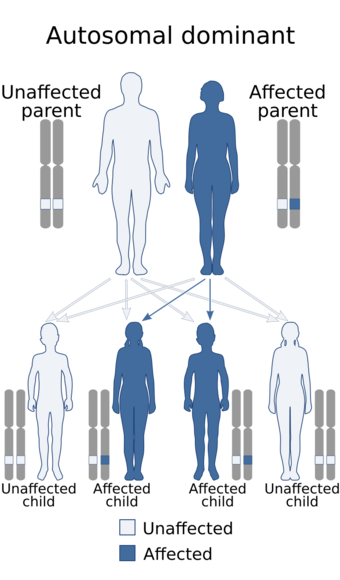Medicine:Hardcastle syndrome
From HandWiki
| Hardcastle syndrome | |
|---|---|
| Other names | Bone dysplasia-medullary fibrosarcoma syndrome, diaphyseal medullary stenosis-malignant fibrous histiocytoma syndrome |
 | |
| Hardcastle syndrome is inherited in an autosomal dominant pattern.[1] | |
Hardcastle syndrome is a rare genetic disorder on chromosome 9 at 9p22-p21.[2] It affects the long bones.[3][4] There is a high risk for histiocytoma.[5]
References
- ↑ McKusick, Victor A.; Kniffin, Cassandra L. (30 June 2015). "OMIM Entry - # 112250 - Diaphyseal medullary stenosis with malignant fibrous histiocytoma; DMSMFH". https://omim.org/entry/112250.
- ↑ Bissonnette, Bruno; Luginbuehl, Igor; Marciniak, Bruno; Dalens, Bernard J. (2006), "Hardcastle Syndrome", Syndromes: Rapid Recognition and Perioperative Implications (The McGraw-Hill Companies), http://accessanesthesiology.mhmedical.com/content.aspx?aid=58079211, retrieved 2019-06-05
- ↑ Norton, K. I.; Wagreich, J. M.; Granowetter, L.; Martignetti, J. A. (September 1996). "Diaphyseal medullary stenosis (sclerosis) with bone malignancy (malignant fibrous histiocytoma): Hardcastle syndrome". Pediatric Radiology 26 (9): 675–677. doi:10.1007/BF01356833. ISSN 0301-0449. PMID 8781110.
- ↑ Jamil, Wiqqas; Allami, Mohammad K.; Mbakada, Nikita; Kluge, Wolfram (December 2009). "Total knee arthroplasty in a patient with Hardcastle syndrome". Orthopedics 32 (12): 916. doi:10.3928/01477447-20091020-20. ISSN 1938-2367. PMID 19968223.
- ↑ "Hardcastle syndrome". https://medical-dictionary.thefreedictionary.com/Hardcastle+syndrome.
External links
| Classification |
|---|
 |

